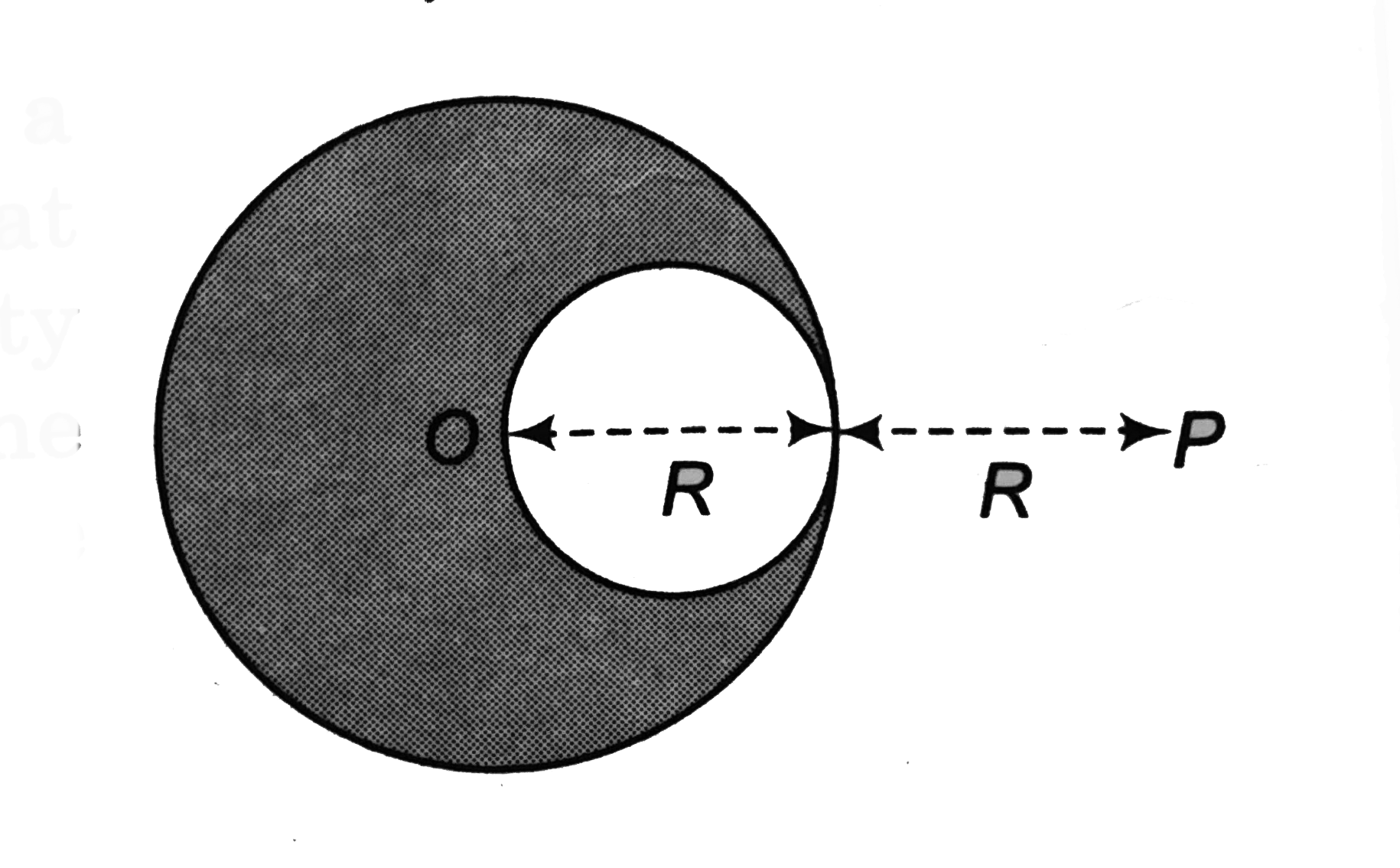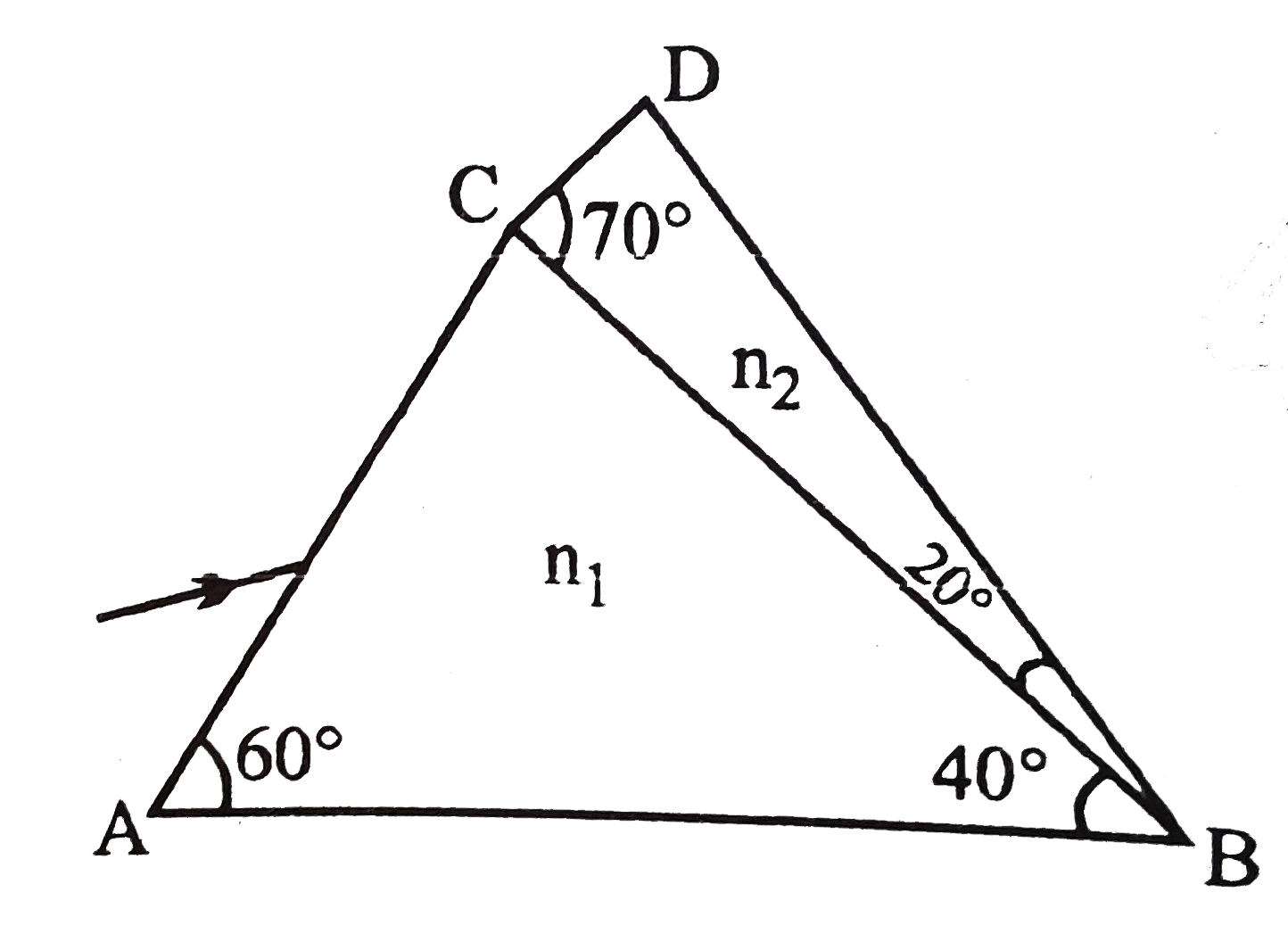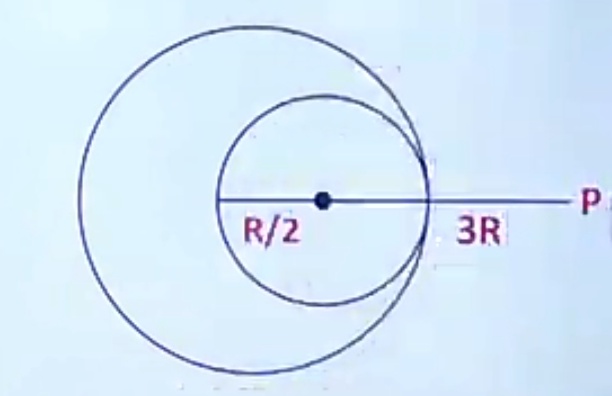A solid sphere of uniform density and radius R applies a gravitational force of attraction equal to F1 on a particle placed at P, distance 2R from the centre O of the sphere. A spherical cavity of radius R/2 is now made in the sphere as shown in figure. The particle with cavity now applies a gravitational force F2 on same particle placed at P. The radio F2/F1 will be
 Solution in Gujrati
Solution in Gujrati
The correct Answer is:79
F1=GMm4R2
F2= force due to whole sphere - force due to cavity
F2=GMm4R2−GMm18R2⇒7GMm36R2∴F2F1=79
Topper's Solved these Questions
- GRAVITATIONBOOK - ALLEN CHAPTER - GRAVITATIONEXERCISE - Exercise 4 B (Brain Storming Subjective Exercise)
20 Videos
- GRAVITATIONBOOK - ALLEN CHAPTER - GRAVITATIONEXERCISE - Exercise 5 A (Previous Year Questions)
26 Videos
- GRAVITATIONBOOK - ALLEN CHAPTER - GRAVITATIONEXERCISE - Exercise 3 (Miscellaneous Type Questions)
20 Videos
- GEOMETRICAL OPTICSBOOK - ALLEN CHAPTER - GEOMETRICAL OPTICSEXERCISE - subjective
14 Videos
- KINEMATICS-2DBOOK - ALLEN CHAPTER - KINEMATICS-2DEXERCISE - Exercise (O-2)
47 Videos
Similar Questions
A small satellite revolves around a heavy planet in a circular orbit. At certain point in its orbit a sharp impulse acts on it and instantaneously increases its kinetic energy to 'k' (<2) times without change in its direction of motion show that in its subsequent motion the ratio of its maximum and minimum distance from the planet is k2−k assuming the mass of the satellite is negligibly small as compared to that of the planet.
View SolutionIf suddenly the gravitational force of attraction between earth and satellite revolving around it becomes zero, then the satellite will
View SolutionStatement-1: Two satellites A & B are in the same orbit around the earth B being behind A. B cannot overtake A by increasing its speed.
Statement-2: it will then go into a different orbit.
View SolutionA prism of refractive index n1 & another prism of reactive index n2 are stuck together without a gap as shown in the figure.The angle of the prisms are as shown. n1&n2depend onλ,the wavelength of light according to n1=1.20+10.8×104λ2&n2=1.45+1.80×104λ2 where λ is in nm.

(i)Calculate the wavelength λ0for which rays incident at any angle on the interfaceBCpass through without bending at that interface.
(ii) for light of wavelength λ0,find the angle of incidencei on faceACsuch that the deviation produced by the combination of prism is minimum.
View SolutionA particle is moving in xy-plane .At certain instant the components of its velocity and acceleration are as follows ux=3m/s,uy=4m/s,ax=2m/s2anday=1m/s2. The rate of change of speed at this moment is
View SolutionA solid sphere of uniform density and radius R applies a gravitational force attraction equal to F_(1) on a particle placed at P , distance 2R from the centre O of the sphere. A spherical cavity of radius R//2 is now made in the sphere as shows in figure. The particle with cavity now applies a gravitational force F_(2) on same particle placed at P . The radio F_(2)//F_(1) will be
View SolutionWhen forces F_(1) , F_(2) , F_(3) are acting on a particle of mass m such that F_(2) and F_(3) are mutually prependicular, then the particle remains stationary. If the force F_(1) is now rejmoved then the acceleration of the particle is
View SolutionThe gravitational force acting on a particle, due to a solid sphere of uniform density and radius R , at a distance of 3R from the centre of the sphere is F_1. A spherical hole of radius (R//2) is now made in the sphere as shown in diagram. The sphere with hole now exerts a force F_2 on the same particle. ratio of F_1 to F_2 is
View SolutionA solid sphere of mass M and radius R has a spherical cavity of radius R/2 such that the centre of cavity is at a distance R/2 from the centre of the sphere. A point mass m is placed inside the cavity at a distanace R/4 from the centre of sphere. The gravitational force on mass m is
View Solutionसमान त्रिज्या के दो चालक गोलों पर +10μC और −20μC के आवेश हैं। जब उनके बीच की दुरी R होती है तो वे F1 बल का अनुभव करते हैं। अब वे परस्पर स्पर्श कराये जाते हैं तथा पुनः उतनी ही दुरी पर रखे जाते हैं। इस स्थिति में वे F2 बल का अनुभव करते हैं। तब F1 और F2 का अनुपात होगा -
View SolutionThe gravitational force acting on a particle due to a solid sphere of uniform density and radius R, at a distance of 3R from the center of the sphere is F_1 . A spherical hole of radius (R/2) is now made in the sphere as shown in the figure . The sphere with hole now exert a force F_2 on the same particle , Ratio of F_1 and F_2 is
View SolutionA solid sphere of uniform density and radius R applies a gravitational force of attraction equal to F1 on a particle placed at P, distance 2R from the centre O of the sphere. A spherical cavity of radius R/2 is now made in the sphere as shown in figure. The particle with cavity now applies a gravitational force F2 on same particle placed at P. The radio F2/F1 will be

View Solutionत्रिज्या R व एकसमान घनत्व वाला ठोस गोला, अपने केन्द्र से 2R दूरी पर रखे एक कण पर गुरुत्वाकर्षण बल F1 लगाता है। गोले में R2 त्रिज्या की गुहा (चित्रानुसार) बनाई जाती है। अब गोला कण पर F2 बल लगाता है F1F1 मान है

View SolutionA solid sphere of uniform density and radius R applies a gravitational force of attraction equal to F_(1) on a particle placed at P , distance 2R from the centre O of the sphere. A spherical cavity of radius R//2 is now made in the sphere as shown in figure. The particle with cavity now applies a gravitational force F_(2) on same particle placed at P . The radio F_(2)//F_(1) will be
View SolutionA solid sphere of uniform density and radius R applies a gravitational force of attraction equal to F_(1) on a particle placed at P, distance 2R from the centre O of the sphere. A spherical cavity of radius R//2 is now made in the sphere as shown in given figure. The sphere with cavity now applies a gravitational force F_(2) on same particle placed at P. The ratio F_(2)//F_(1) will be
View SolutionA solid sphere of uniform density and radius R applies a gravitational force of attraction equal to F1 on a particle placed at a distance 3R from the center of the sphere. The 1 sphere with the cavity now applies a gravitational force F2, on the same particle. Then ratio F1F2 is

View Solution
